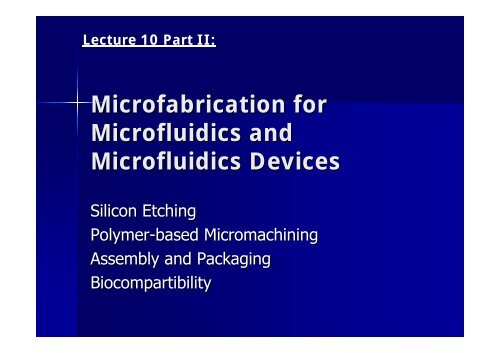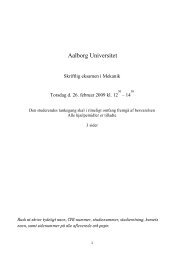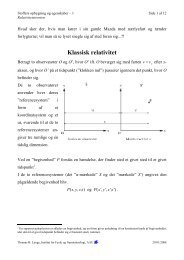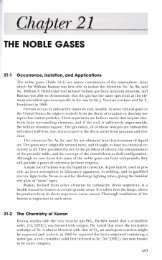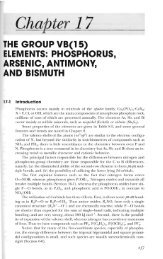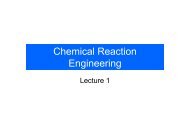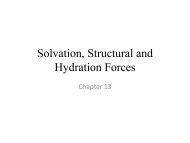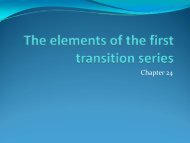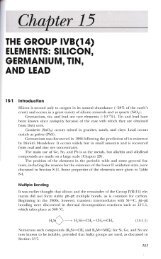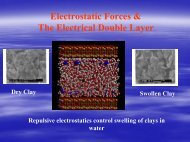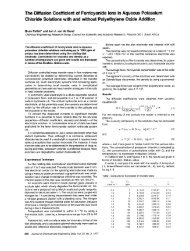Fabrication of microfluidic devices
Fabrication of microfluidic devices
Fabrication of microfluidic devices
- No tags were found...
You also want an ePaper? Increase the reach of your titles
YUMPU automatically turns print PDFs into web optimized ePapers that Google loves.
Lecture 10 Part II:Micr<strong>of</strong>abrication forMicr<strong>of</strong>luidics andMicr<strong>of</strong>luidics DevicesSilicon EtchingPolymer-basedMicromachiningAssembly and PackagingBiocompartibility
Techniques involved:• Wet etching <strong>of</strong> channels in Si and glass(isotropic, anysotropic)• Dry etching• Resist lithography• PDMS s<strong>of</strong>t lithography• Hot embossing• Other machining techniques in plastics,glass etc.• Bonding
Wet etching <strong>of</strong> (100) Silicon
Wet etching <strong>of</strong> other orientation <strong>of</strong>Silicon
Isotropic etching <strong>of</strong> Silicon andGlassSilicon:Etchant: 66% HNO3 and 34% HFEtching rate: 5um/minGlass:Etchant: HF (or BHF)
Chemical dry etching• Deep trenches with highaspect ratios can bemade in Si, glass orplastic• Gases used:– Fluorine chemistry (CHF 3 ,SF 6 , CF 4 )– Chlorine chemistry (HCl(HCl,Cl 2 )– Oxygen
Bulk micromachined channels
Silicon surface micromachiningPECVD oxideoxidePECVD oxidewet etching
Polymer based micromachining• Thick resist lithography• Polymeric based micromachining• S<strong>of</strong>t lithography• Microstereo lithography• Micromolding
SU-8 resist• Negative photoresist for NUV exposureReally Reallythick thicklayers layersin in one onespin!L/S10/30 20/60 30/90
Example <strong>of</strong> SU-8 structures<strong>Fabrication</strong> <strong>of</strong> open channels<strong>Fabrication</strong> <strong>of</strong> covered channelsembeddedmaskselectiveproton writingsacrif.layer
S<strong>of</strong>t lithography• Uses elastomeric stamp, usually PDMS(Polydimethylsiloxane)) to transfer the pattern.– Microcontact printing– Micromolding
<strong>Fabrication</strong> <strong>of</strong> microchannels usings<strong>of</strong>t lithography• Advantages <strong>of</strong> PDMS:– Low cost– Transparency in VIS and NUV– Chemically inert• Technology:– Mix prepolymer and curing agent 10:1 – 5:1– Pour into solid master made in SU-8 with inlets defined byglass posts– Cure at 60 – 80 oC for couple <strong>of</strong> hours– Peel <strong>of</strong>f– treat with ozon or Oxygen plasma and attach to cleanglass, silicon or another PDMS
Microstereo lithographySingle photon adsorbtionTwo photon absorbtionLayer-by-Layer photolithography
Micromolding• Injection molding: high pressure injection <strong>of</strong> moltenPMMA, PC (polycarbonate(polycarbonate), PSU (polysulfone(polysulfone) ) etc.• Compression molding (hot embossing)
Other micromachining techniques• Laser micromachinig(usuallyusing an excimer lasers,Nd:YAG or CO 2 lasers)• Focused ion beam• Microelectro discharge• Ultrasonic micromachining
Assembly and packaging• Anodic bonding(T=400 o C, , V=1kV)• Silicon direct bondingreaction <strong>of</strong> OH groups on Si surfaces at T=300 – 1000 o C• Glass direct bonding(T=600 o C for 6-8h) 6• Polymer direct bonding• Adhesive bonding (lowmelting glass (400-600o C, photoresists,UV curable epoxies, epoxies etc.)• Eutectic bonding (e.g.. gold/siliconeutectic at 363 o C)
Other micr<strong>of</strong>abrication issues:Biocompartibility• Material responce to biologicalenvironments (swelling, corrosion etc.)• Tissue and cellular responce to thematerial
Micr<strong>of</strong>luidics: Devices forFlow Control•Valves•Pumps•Micromixers
Microvalve consist <strong>of</strong> closure element driven by an actuatorNormally openActive MicrovalvesNormally closedBistableActive MicrovalvesAnalogDigitalAnalogDigitalPulse-width modulationFluidic DAC
Active MicrovalvesPneumaticThermopneumaticThermomechanicalPiezoelectricElectrostaticElectromagneticElectrochemicalCapillary forcelActuation principle
Valve specification:• leakage• valve capacityLvalveQ=Q• power consumption – total power consumption in active state• closing force (pressure range) – pressure generated by the valve• temperature range• responce time• reliability• biocompartibility• chemical compartibilityclosedopenC valve=∆pQmaxmax/( ρg)
Design considerations• Specification required• Materials to be used• Cost• Suitable type <strong>of</strong> actuators• Optimal valve spring and valve seat
Design consideration: Actuators• Moving function (enoughforce, displacement andcontrollability)• Holding function (shouldkeep valve in a setposition)• Dynamic function (requiredresponce time)Energy density:E ='aFasVaa
Design consideration: Valve spring• For normally closed valves (NC) – large spring constant to resist thepressure• For normally open valves (NO) – s<strong>of</strong>t spring constant, optimized foractuator closing force
Design consideration: Valve seatMain requirements:• Zero leakage• Resistance against particles trapped
Design consideration: PressurecompensationAim: Maintain closing force when the inletpressure varyPassive flow controller
Stack <strong>of</strong> 3 directly bonded Si wafers, Simembrane 25 um thickSilicon rubber membrane 25 um thick preparedby spin coating, hole drilled with laserSilicon rubber membrane 30 um thick preparedby surface micromachinig, photoresist used asa sacrificial layer.Boron implantationTypical parameters <strong>of</strong> pneumatic valves:
Thermopneumatic valves• Relies on the change in volume <strong>of</strong> sealedliquid or solid under thermal loading. Usuallyutilize solid/liquidliquid and liquid/gasphasetransition for maximum performance
Example• Thermopneumatic valve with air.Height <strong>of</strong> the expansion cylinder500um.• Assuming the volume constant:T1 p1p2109.67= → T2= T1= 300 = 329K=T p p 10022156C
Example
Design examplesHeater is placed on SiN membrane, 50umSilicon rubber used for membrane9um paraffin used as actuation material2um deflection with 50mW heating
Thermomechanical valves• Solid expansion• Bimetallic• Shape-memoryalloys
Solid expansion valves• Generated force:F ∝ γ∆Twhere γ is the thermal expansion coefficient
Bimetallic valves• Uses difference in thermal expansion coefficient <strong>of</strong> two metalsF ∝ γ 2−γ) ∆T(1
Bimetallic valves: : Design examples
Shape memory Alloy valves• Shape memory alloys (SMA) are materials that have propertyto return to their original undeformed shape upon a change <strong>of</strong>temperature• Advantages: high force and large stroke• Disadvantages: low efficiency, low frequency (bandwidth)
Piezolelectric valves• generate small strain (0.1%) and high stresses (MPa(MPa),therefore suitable for applications with high force and lowdisplacementϕ = ϕ = dlvtϕ = d33Eel31Eel
Example:
Design examples
Electrostatic valve• Based on attractive force between two oppositely chargedplatesVF 1 2−= εrε A() , 8.854*10120ε0=F / m2 d• Advantages: : fast responce• Disadvantages: high voltage and small discplacement
Design examples
Electromagnetic valves• Uses solenoid actuator with a magnetic core and a coil• Advantage: : large deflection• Disadvantage: low efficiency
Design examples
Electrochemical valves• Actuated by a bubble created by water electrolysisConsumes 4.3uW (10000 smaller that thermopneumatic !!!)2.5 V operational voltage
Capillary force valvesCapacity <strong>of</strong> double layer.• ElectrocapillaryMaximum value <strong>of</strong> surface tension at V 0.
Thermocapillary effect• Caused by temperature dependence <strong>of</strong> surfacetension: viscosity and surface tension both dropwith the temperature increase
Passive capillary effectExample: a bubble valve is designed with a vapour bubble betweenchannel sections 50um and 200um sections. What pressure can itwithstand?σ w=72*10 -3 N/m
Micropumps• micropumpsmechanicalNon-mechanical
Mechanical pumps• Require an electromechanical actuator, eitherexternal or integrated• External actuators: drawback: : large size,advantages: : large force and displacement.• Integrated actuators: : fast responce and reliability
Parameters <strong>of</strong> micropumps• Maximum flow rate (determined(at 0 back pressure)• Maximum back pressure (at which flow becomes 0),also described as pump head• Pump efficiency
Check-valvepump• Function under conditions <strong>of</strong> small compression ration andhigh pump pressure– Compression ratio– High pump pressureDesign rules• Minimize critical pressure• Maximize stroke volume• Minimize the dead volume• Maximize the pump pressure using large force actuators
Design examples• Typical micro check valves
Peristalstic pumps• Do not require passive valves to set flow direction• Require 3 or more chambers (actuallyjust valvesconnected in seria)• Drawbacks: leakage and small pressure difference,require a one check valve to prevent back flow• Design rules: : large stroke and large compressionratio.
Example• A peristaltic pump has 3 chambers and 3 circularunimorph piezodiscs, membrane diameter 4mm,frequency 100Hz, maximum deflection 40um.
Design examples
Valvless rectification pumps• Diffusers/nozzlesused instead <strong>of</strong> check valves forflow rectification∆p= ξpu2Fluidic diodicity:2ξ - pressure loss coefficientξηF=ξnegativepositiveFlow rate:Q=2∆VfηηFF−1+ 1χ - rectification efficiency
Design examplesTesla pump:χ=0.045, η=1.2
Micromixers• mixing in microscale relies mainly ondiffusion due to laminar flow at lowReynolds numbersτ =2d2D
Lamination in mixer• parallel lamination• sequential lamination
Focusing in mixer• geometric and hydrodynamic focusing
Mixing by twisting theflowStroockA. D., DertingerS. K. W., AjdariA., MezicI., Stone H. A., Whitesides G. M.“Chaotic Mixer for Microchannels” Science 295, 647-651 (2002)
Electrohydrodynamicmixing• Difference in liquids conductivities and permittivitiescreated transversal flows across the interface anddestabilized it, promoting mixing.
Magnetoelectrodynamicmixing• Alternating electric fields were applied to the chamber with twoindependent center electrodes in the presence <strong>of</strong> a magnetic field
Mechanical mixing• Stirring• Oscillating walls• Magnetic particles etc.


